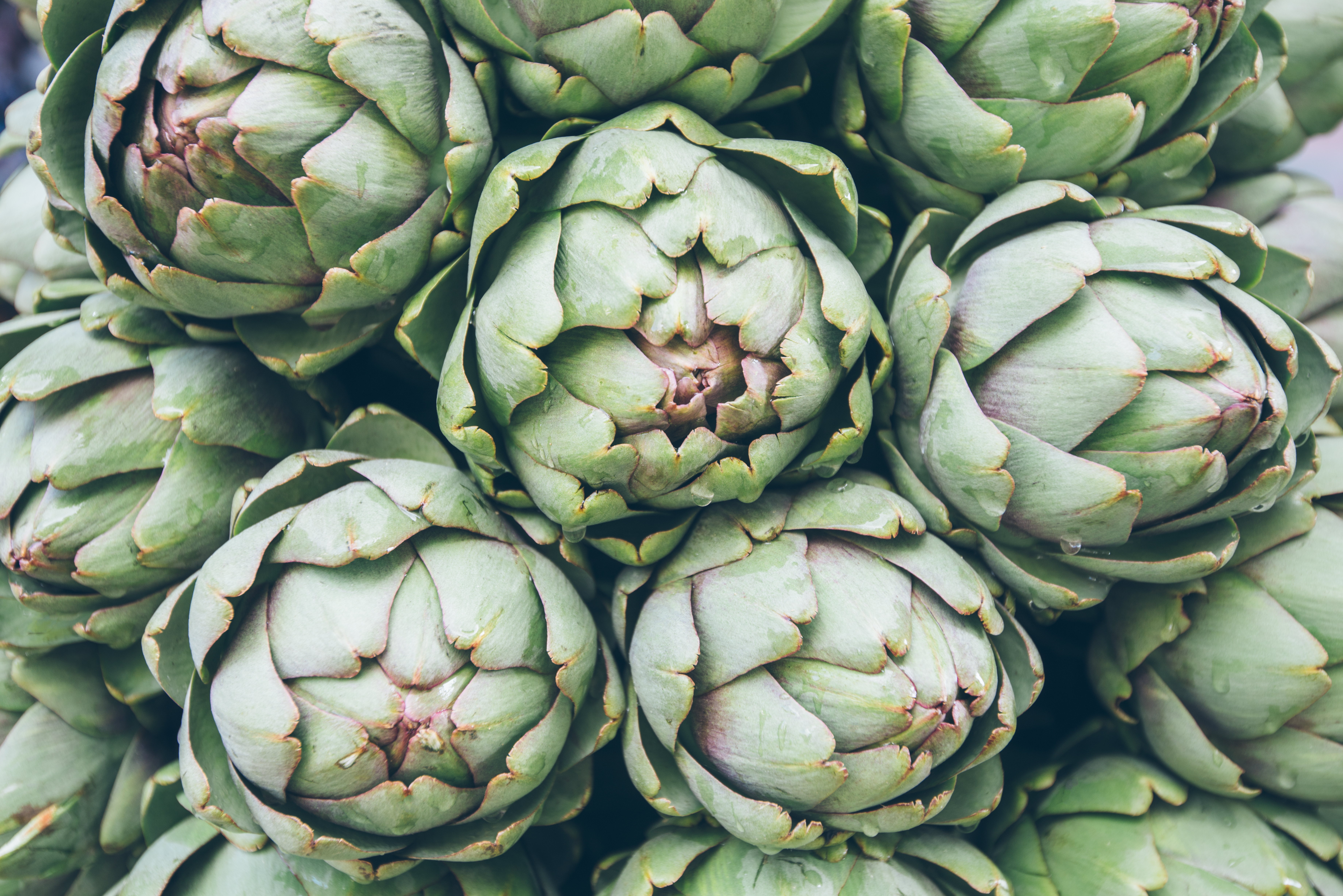
Produce 101: Artichokes
The artichoke was well known in ancient Rome, being mentioned as far back as 300 BC. Throughout history, the artichoke was prized for not only for its delicious flavor, but as a key medicinal plant. Uses included diuretic aid, nausea remedy, liver tonic, as an aphrodisiac, a digestive aid, a breath freshener, and even as a deodorant. The wealthier Roman citizens ate them pickled in honey and vinegar and seasoned with cumin.
We have come a long way since then, and thankfully we see them mostly on our menus–rather than our medicine cabinet.
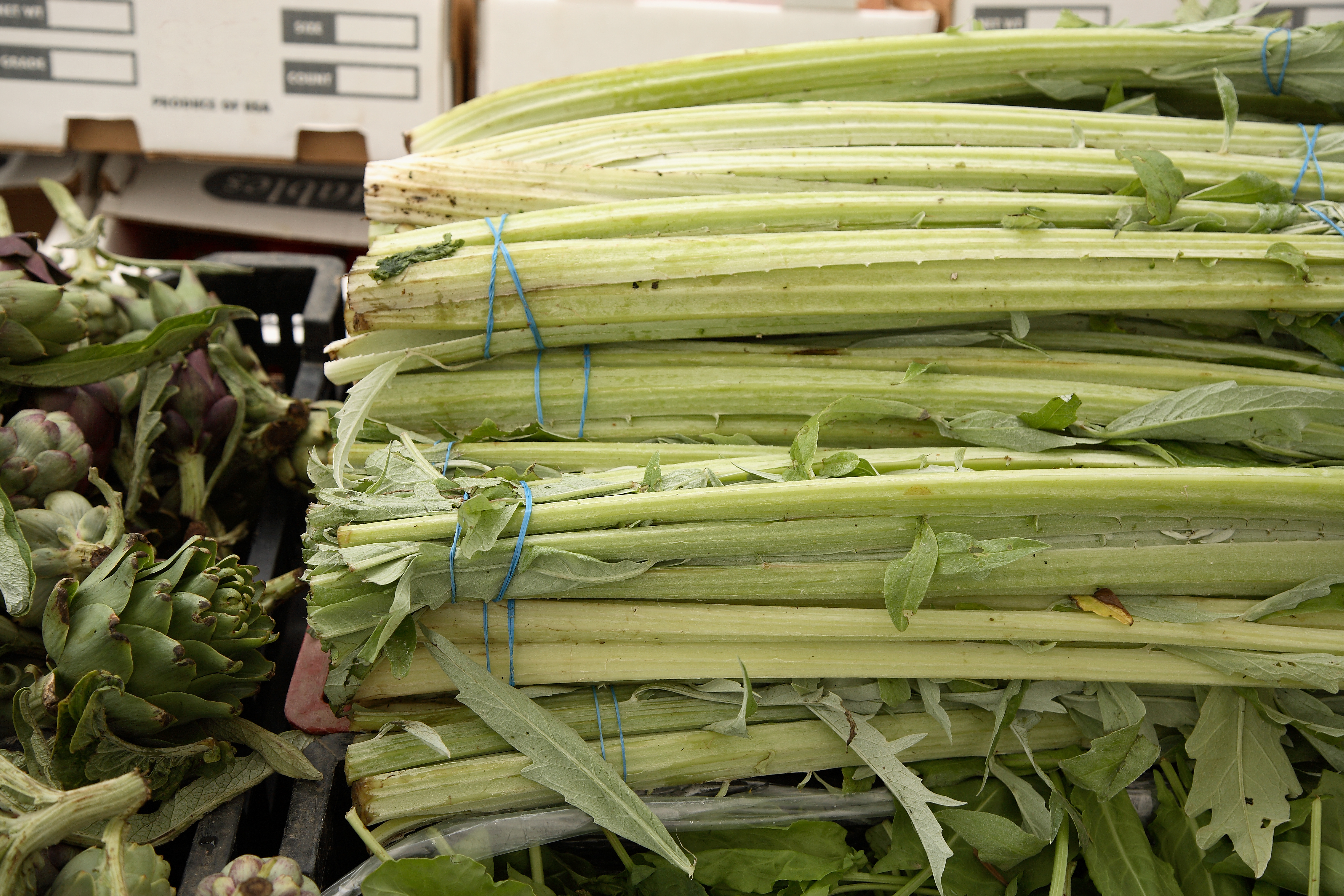
How Did the Artichoke Become Popular?
Historians indicate that the artichoke evolved from the Cardoon, developing a flower that was eaten, as opposed to the stalks. A Cardoon has a celery-like appearance with stalks that taste like an artichoke heart, and it is still referred to by many as a wild artichoke. You can see their celery-like appearance in the image above.
Artichokes made their way across the Atlantic with the early French settlers. Grown by Thomas Jefferson in Monticello in 1770, he also used “artichoke” as a keyword in his cipher (coded messages) to protect prying eyes from his important messages with Meriwether Lewis, later to be known of Lewis and Clark fame.
Now, all commercial artichokes grown domestically are raised in California, with Castroville being the artichoke growing capital.

Produce 101: Artichokes & Appearance
Artichokes, even in their best state, are never the most beautiful item out of the box. It is common to see some russeting or some rub damage. These are external cosmetic problems though, which are usually mitigated by cooking by either plunging into boiling water, roasting, or grilling–all of which disguise that cosmetic issue.
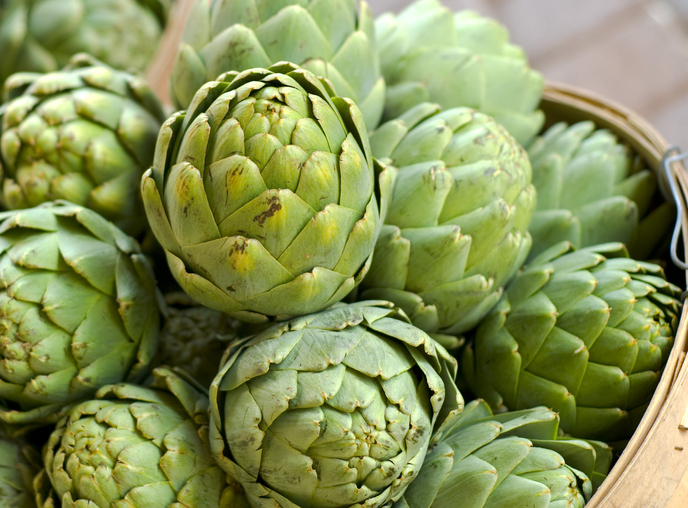
Artichoke Frost Damage Is Only Cosmetic
When the temperatures start to dip, you may also see some frost damage. Ocean Mist actually calls it “Frost Kissed®” with the description of “California winter frosts can yield “Frost Kissed” artichokes that are available in stores for a limited time. Frost causes the outer layer of the artichoke to turn brown, flake and peel, much like we do after getting sunburned.” Since most cosmetic issues are solved during cooking, and these are known to have a more “nutty” and “intense” taste, enjoy them in all their Frost Kissed glory–this is not a quality issue.
What Else To Look For When Choosing an Artichoke
Pick up your artichoke, you want it to be heavy for its size. You want to squeeze it, you don’t want those leaves to move much or make much of a squeaking sound. You want to feel the heart, which is the prized part of the artichoke, with minimal touch and effort.
Should You Choose a Thorned Artichoke?
Certain varieties of artichokes have thorns, and those thorns can hook you during prep if you are not careful. Don’t be too quick to look for “thornless” varieties. The thornless varieties don’t yield as much, the flavor is not an intense, and the thorns aren’t that bad since they soften after cooking, so go for the thorned variety if you want a better yield and flavor.
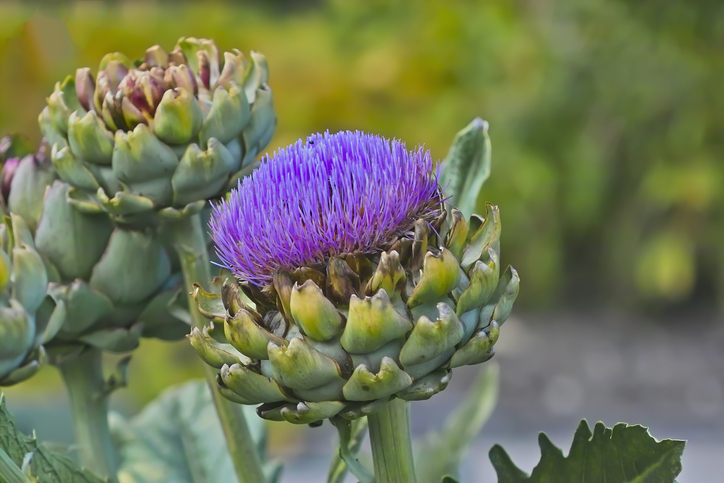
Artichokes are an Edible Flower
The artichoke and its wild cousin the Cardoon, are members of the thistle family. In fact, the portion of the artichoke that we eat is actually the unopened flower bud, which if allowed to fully mature, will open up into a vibrant purple-hued thistle-looking flower.
Produce 101: Artichokes, Grades, and Sizes
How do you use artichokes, and really why did anybody start? Well, let’s talk about the technical part.
The USDA has three grades based mainly on uniformity of size, color, insect defects, and only refers to artichokes grown in six California coastal counties.
- US No. 1
- US No. 2
- US No. 1 Long Stem
Artichokes are typically sold with a short stem, but to get the Long Stem grade, this needs to be a minimum of 8″ long.
Yes, the stem is edible, it’s a little woody, just peel it down. You can trim and cook them alongside your artichokes, and makes an excellent chef snack :)
Artichoke Sizes
Commonly you see 18 count artichokes which is a good size, but we’ve seen them as big as a 12 count, and as small as a 48 count. What those numbers mean: that’s the number of artichokes that will fit in a standard 20 lb box.
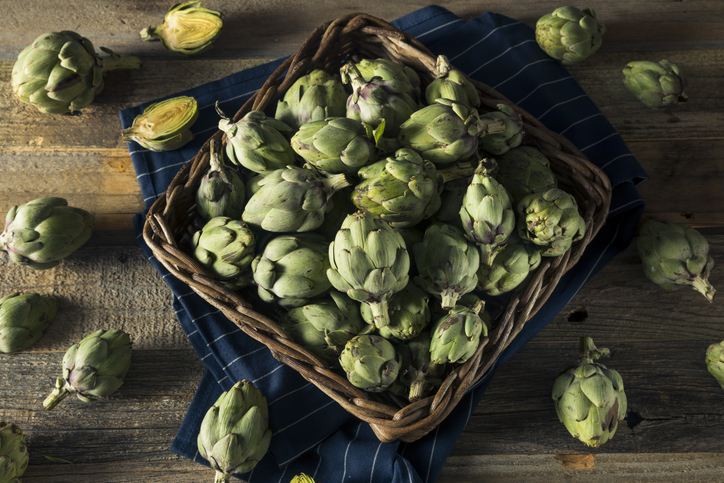
Baby Artichokes
Baby artichokes are from the same plant as the larger sizes. More sunlight means larger artichokes, and babies are harvested on the bottom of the plant.
Why use a smaller artichoke, that seems like a lot of prep work?
The biggest advantage of a baby artichoke is that the choke is a lot smaller, in fact, most baby artichokes won’t have a choke at all. To prep them, just trim the leaves a little and they can go straight to the grill or steamer for a quick ready-to-go side.
The smaller the artichoke, the more tender the leaves as well, which means, baby artichokes are almost entirely edible. The larger the artichoke, the more woody the leaves, and those large tough leaves are unpalatable.
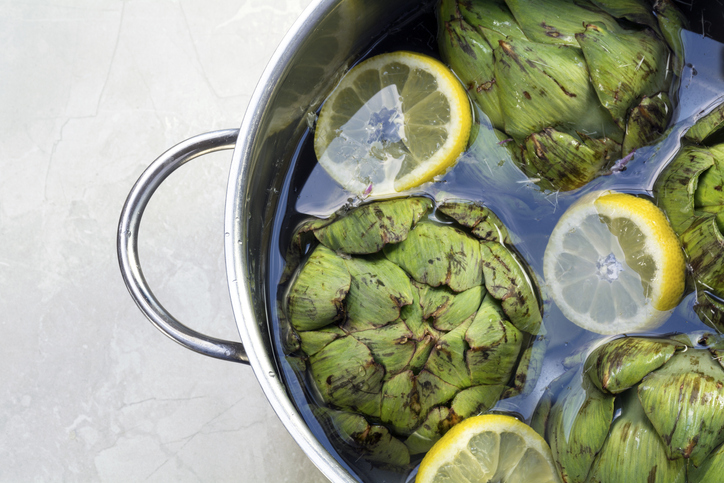
Produce 101: Artichokes and Prep Tips
When cooking and prepping artichokes, you want to have on hand plenty of acidulated water with lemon juice. This will help to prevent the artichoke from discoloring, and it gets discolored pretty quick. The flesh will go from a nice beige to a gunmetal gray almost instantaneously. It will still discolor and the acidulated water will help, but it won’t be as bad. While the discoloration doesn’t really affect the flavor, it is unappealing to the eye.
When cleaning an artichoke, you want to start by trimming the leaves–get rid of those thorns, because they can hook you and be a little painful. When you cut into them, inside is a clump of what looks like little purple needles–that’s what we call the “choke”. Those are the actual petals to the flower. While they’re certainly not going to hurt you, they’re not edible and the texture it is like eating hay, so just scoop them out with a spoon. Cut it about halfway down and scoop the choke out, then trim the leaves, and then the stem. Alternately, you can cook them first to make the choke removal easier, too.
They are great just steamed, roasted, or grilled, but really shine with an aioli-type dipping sauce. They make a fun appetizer to share, with each person plucking off each leaf, dipping into the sauce, and scraping off the little bit of meaty heart with your teeth.
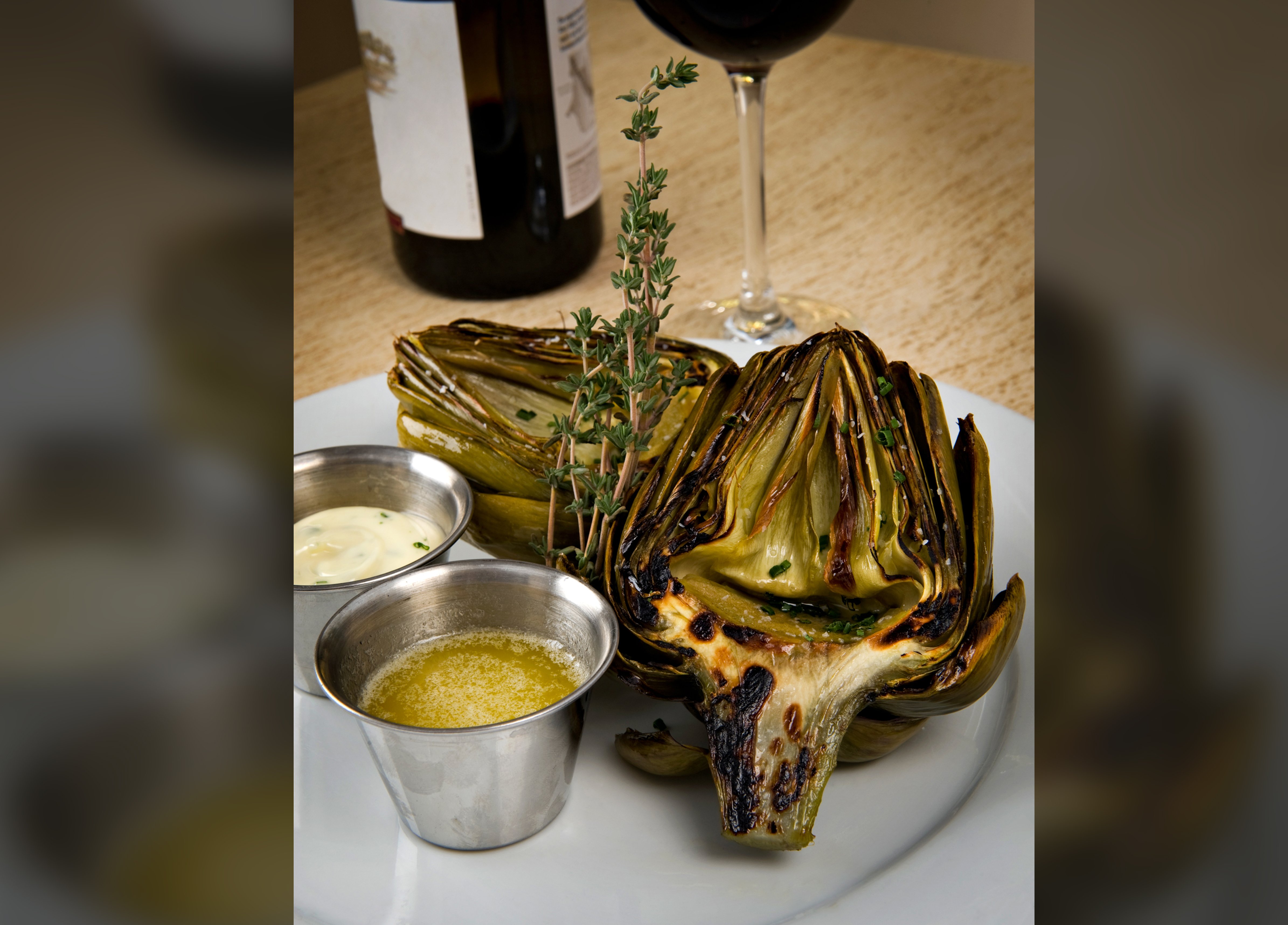
Paring Wine With Artichokes
Pairing artichokes and wine can be tricky, and chefs may want to work closely with their sommeliers on selection. It can be done successfully, but you just have to know have to know how to play their strengths. The reason? According to Mary Gorman-McAdams, in The Kitchn, “Artichokes are challenging because they contain a chemical acid called ‘cynarin’, which makes everything taste sweeter — especially the wine.”
Produce 101: Artichokes–An Interesting History Lesson
Artichokes have a bit of a nefarious history as well. In 1935, the New York City Artichoke Wars were in full swing. Ciro “The Artichoke King” Terranova was an underboss with the notorious Morello Family, who would purchase all the artichokes in New York and them mark them up for a large profit. Of course, in true mob fashion, this became ugly. Mayor Fiorello La Guardia stepped in and banned their sale of artichokes. Thankfully the ban has since been lifted.
Ending on a lighter note–in 1948 a young Norma Jeane Mortenson was awarded the honorary title of the first official “Artichoke Queen” of the Castroville Artichoke Festival. Ms. Mortenson would later gain worldwide fame as Marilyn Monroe.
Up next, Dan talks about Produce 101: Artichokes
Contact your Sales Consultant about adding artichokes to your next order. If you are not a customer, find out how to become one today!
Content provided by Chef Daniel Snowden, the Director of Culinary Development for FreshPoint Central Florida. He has been in the produce industry almost 20 years and loves getting geeky about food. Additional contributions by Lisa Brizard.
Some tools you can use:
Visit freshpoint.com for our seasonal availability guides—and while you are there, check out the FreshPress, our latest market report. Place your orders online with ease at myfreshpoint.com. Did you know you can receive real-time reliable delivery alerts on the day of your delivery? Activate and subscribe at FreshPoint.com/mydelivery
Download our app and take your produce management on the go. Place orders, review flyers, watch videos…all in one spot!
Find out more details about our UBU program, and how we are shining a spotlight on food waste while making value and food safety a priority.
We buy local to strengthen regional economies, support family farms, preserve the local landscape, and to provide fresh-from-the-farm food to our customers. Local.freshpoint.com connects you to your local farmers like never before! Customize your search by zip, city, state, radius…even by crops and growing methods. Pop in your zip code and learn about our local farmers.
Socialize with us!
Did you know we are on YouTube? Head over to our page and check out our 75+ videos. Don’t forget to subscribe, and also be a part of our Bell Team—hit the little bell icon to get notifications when we upload new videos.
Follow FreshPoint, Inc. on Facebook, Twitter, Instagram, and LinkedIn…and follow The Produce Hunter on Instagram as she finds the best specialty produce at the Santa Monica Farmers Market.

